

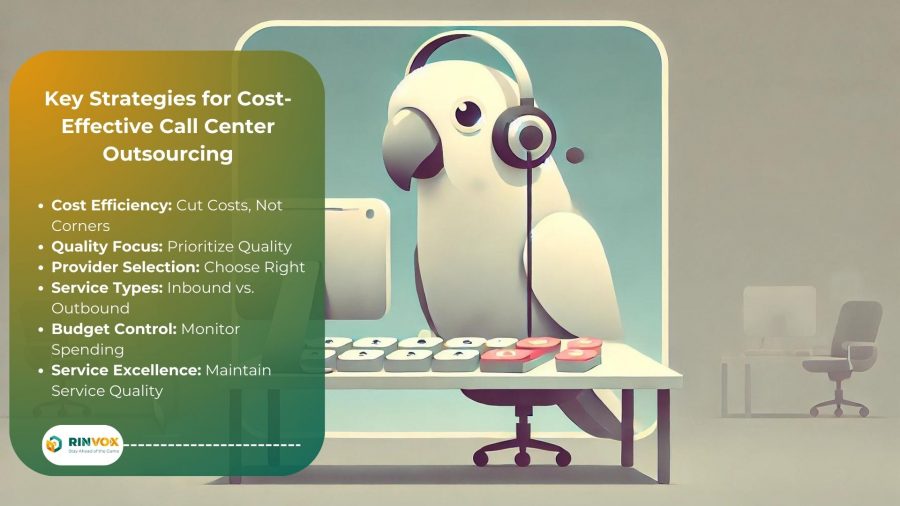

Contact Center Pricing: Save Big with Smart Tips
Top Contact Center Pricing Models: What to Expect [+ Pro Tips]
Cut costs, not corners.
We get it; as a savvy business owner, you’re always on the lookout for ways to save money without sacrificing quality. And if you’re considering using an outsourced call center, choosing the right service provider & the best contact center pricing is key to streamlining your operations efficiently.
Whether you need an outbound call center to push sales or an inbound call center to improve customer support, there’s a fit for every need.
Now, Let’s get into the different contact call center pricing models. We’ll show you how to keep offering great customer service while also watching your budget.

Optimized Call Center Operations at Rinvox.
Types of Contact Center Pricing Models
Call center outsourcing costs can change a lot. It depends on what kind of help you need, where the call center is located, and if you want agents who work just for your company. Let’s break it down into more details:
1. Shared Services
For companies that have busy and quiet times, it’s smart to use shared services. This means call center agents help multiple clients, not just one. It’s a good way to cut costs because you’re sharing agents with other businesses.
- Pricing: Generally, you pay by the minute for shared services. Rates might vary from 75 cents to $1.25 each minute, depending on how complex the calls are and what skills the agents need to have.
Shared services can impact customer satisfaction by reducing wait times and improving service quality.
Tip: Schedule shared agents during your peak call times.
2. Dedicated Agents
If you want 24/7 customer support, use dedicated agents. They’re always ready to help, improving response times and boosting customer satisfaction.
How Much Does It Cost? Dedicated agents get paid by the hour. Depending on where they are and their skills, you might pay anywhere from $22 to $35 per hour in the U.S.
Tip: Negotiate flat rates for predictable budgeting.
3. Monthly Plans
Monthly plans are great for businesses that know how many calls they’ll get each month. You pay a set price for a certain amount of service time.
These plans usually come in different levels. For instance, a simple plan might give you up to 100 hours each month for $2000. Bigger plans might include 500 hours for $8000. Monthly plans also offer scalability to accommodate changing business needs.
Tip: Choose a plan slightly above your average needs.

Visual Guide to Contact Center Pricing Models at Rinvox.
Key Considerations
Picking the right price plan for a call center isn’t just about the numbers. Here’s what to keep in mind:
- Experience Matters: You’ll pay more for agents who know their stuff. Make sure you know exactly what kind of skills your agents need to handle your calls well.
- Task Difficulty: If the work is tricky and needs a lot of know-how, it’ll cost more. Figure out how tough the jobs are so you pick a price plan that makes sense.
- Time Commitment: Sticking with one service for a long time can cut down your costs. Longer deals often mean cheaper rates because they help the call center plan better.
Tip: Match agent expertise to task complexity, optimize costs.
Factors Affecting Pricing
The cost of call center services isn’t just about numbers; it’s about value. Different types of call centers, such as inbound call centers and outbound call centers, significantly impact pricing. Inbound call centers typically handle customer service and support, while outbound call centers are more focused on sales and marketing efforts. Here are the factors that tweak the pricing dial:
1. Type of Service
The purpose of your call center greatly affects costs. Outbound centers, like telemarketing, often need more support and incur higher expenses.
- Inbound Customer Support: Inbound call centers handle customer queries and complaints, usually costing 80 cents to $1.50 per minute, depending on call complexity and volume.
- Outbound Sales Efforts: Outbound call centers include telemarketing and follow-ups, requiring skilled, assertive tactics. Costs range from $1 to $2 per minute, influenced by service quality.
Tip: Define goals first, then tailor your budget accordingly
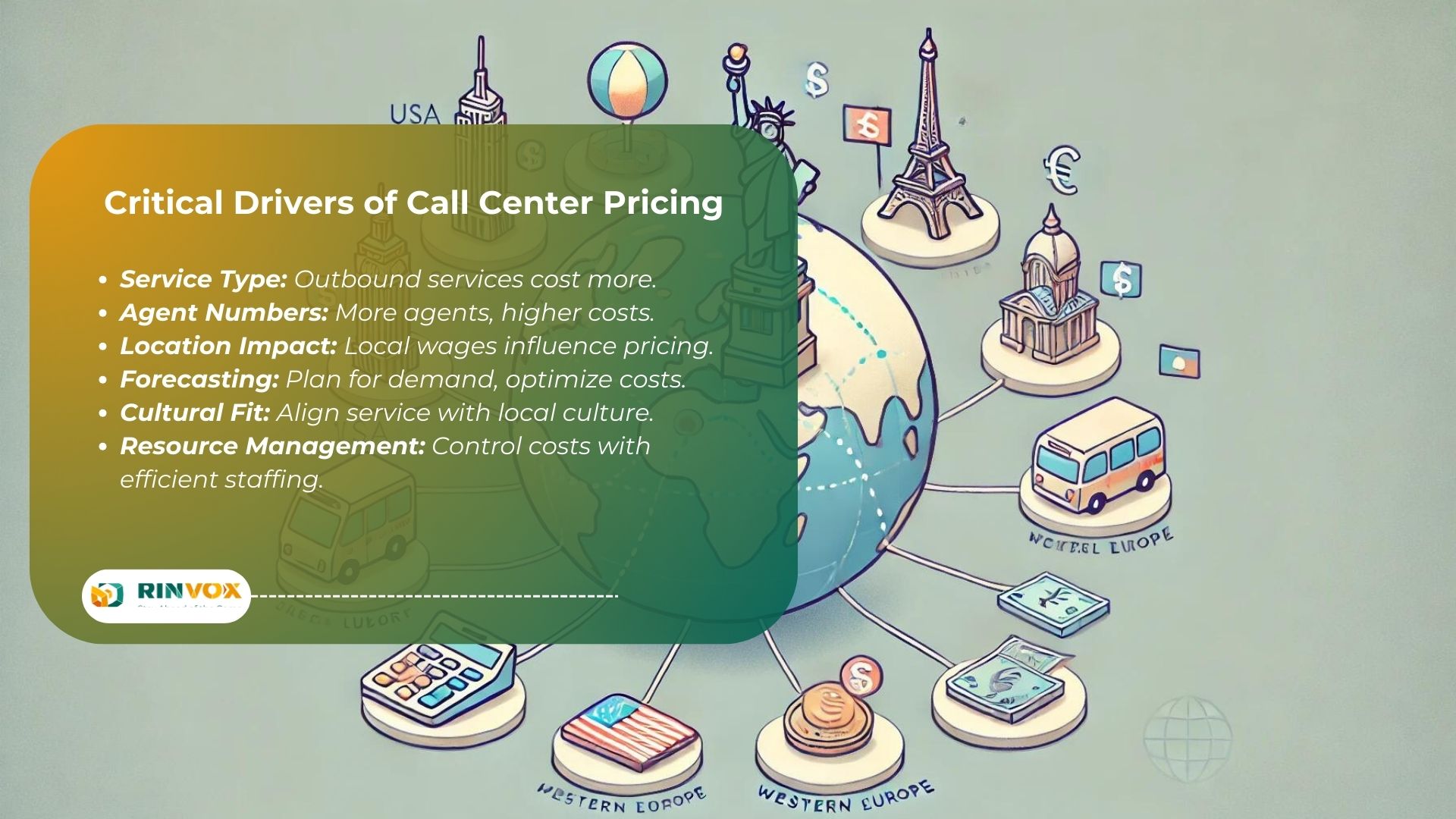
Global Cost Comparison of Call Centers by Region.
2. Agent Numbers
The number of agents you need directly impacts your overall costs. Scaling operations up or down quickly can also affect per-agent rates due to training and management needs.
- Number of agents: This is a big one. More agents mean higher total costs. If you scale up or down quickly, it could change how much you’re paying for each agent because of the extra training and management they’ll need.
- Smaller teams are pricier per person: When you have just a few agents, you might pay more for each one because there’s less chance to spread out costs.
- Bigger teams can save money per person: On the other hand, if you hire a lot of agents, you can often pay less for each one. That’s because you’re training lots of people at once and spreading other costs over a bigger group.
Effective workforce management can help optimize agent numbers and control costs.
Tip: Forecast demand, start small, scale agents as needed.
3. Geographical Location
The location of your call center affects costs due to local wages, economic conditions, and typical regional charges.
- Expensive Places: In places like the USA, Canada, and Western Europe, hiring a call center might cost you between $25 to $40 every hour.
- Cheaper Spots: On the other hand, in places like the Philippines, India, and Eastern Europe, it’s a lot cheaper. Here, you might only pay between $8 to $15 an hour.
Tip: Balance costs with cultural and linguistic alignment.
Contact Center Pricing by Location

Hourly Rates of Call Center Agents Across Different Regions.
Outsourcing costs vary by location due to differences in wages, economy, and local norms. Choose your outsourcing site wisely to balance cost and quality.
Asia, Africa, and the Philippines
- Asia (India, Malaysia): In these places, you can find all kinds of services like tech support and customer help. The cost usually falls between $6 and $12 an hour.
- Africa (Kenya, South Africa): Kenya and South Africa are rising stars for affordable outsourcing, offering multilingual support at rates between $8 and $15 per hour.
- Philippines: The Philippines offers excellent English-speaking customer service at $8 to $14 per hour. Outsourcing here can save businesses significant money.
Tip: Evaluate communication, tech skills, and costs by region.
Western & Eastern Europe
In these parts of Europe, running a business costs more, but you get top-notch services, especially when you need help in several languages.
- In Western Europe, including the UK and Germany, services cost more due to a strong economy and high wages. Expect to pay $20 to $40 per hour for professional, multilingual services.
- Eastern Europe, like Poland and Romania, offers tech services between $12 and $25 per hour. Skilled in tech and multilingual, it balances cost and quality well.
Here’s a tip: Consider Eastern Europe for cost-effective, multilingual services.
North America
Call centers in North America usually cost more to run, but they’re worth it if you need top-notch service without language or cultural hassles for customers in the U.S. and Canada.
In these two countries, you’ll find that hourly rates for call centers can range between $22 and $50. This price reflects the high quality of service and communication skills that are expected here. North American call centers often provide ‘premium services’ that justify their higher costs.
Tip: Choose local for cultural familiarity and language precision.
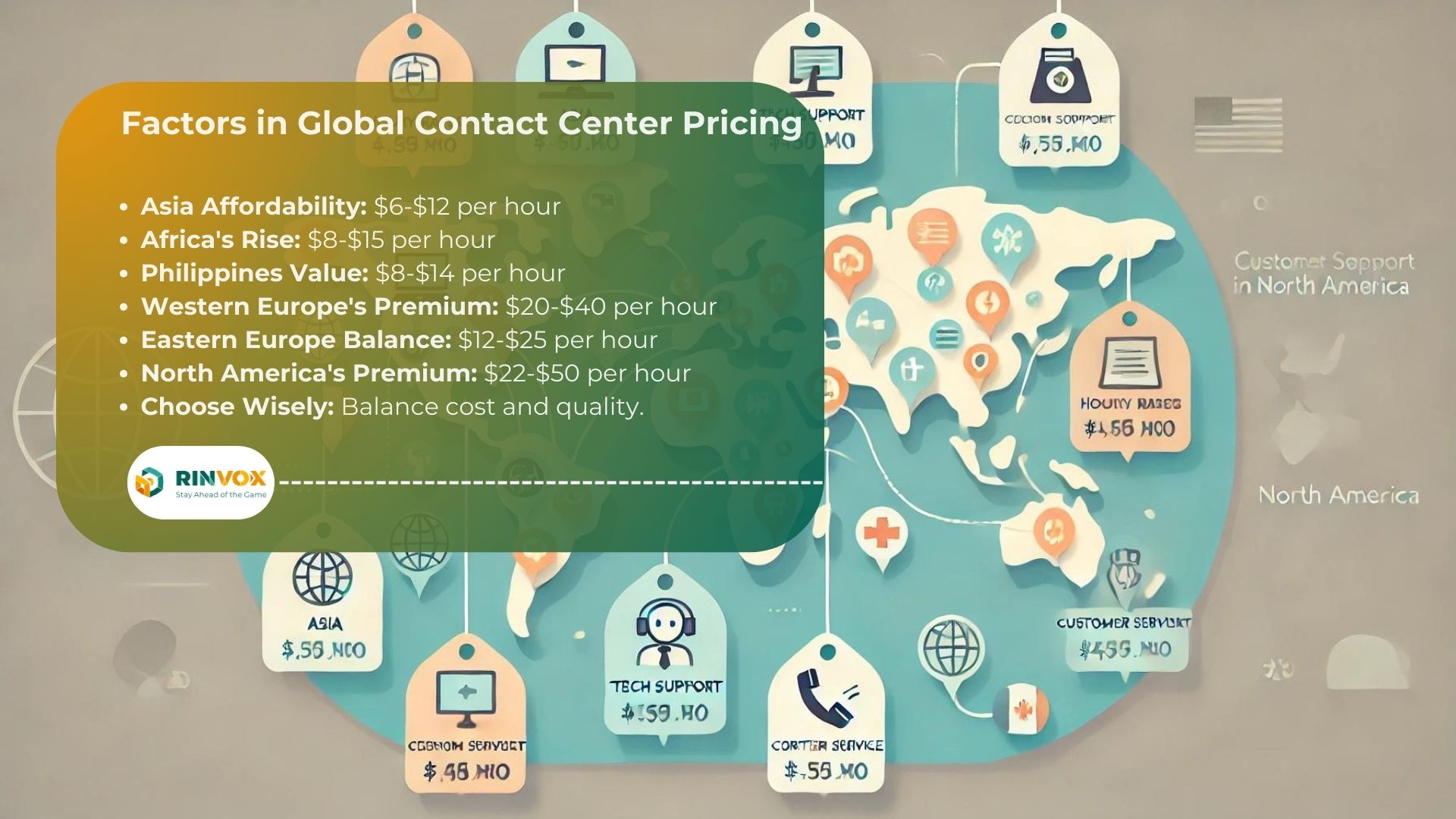
Hourly Rates of Call Centers Globally by Region.
Call Center Software Costs
Besides people costs, the software also plays a big part in how much you spend on call center services:
Software-as-a-service models can offer flexibility and cost savings for call centers.
One-off Fees
These are the initial expenses to get your software up and running perfectly for your needs.
- Setup Fees: Setup fees cover installing software and integrating it with your systems. Costs range from $500 to $5,000, depending on the software’s complexity and your operation’s size.
- Training Fees: Proper software training is crucial. It costs $1,000 to $3,000, depending on the training depth and team size.
The initial investment in setup and training fees can significantly impact the overall cost of call center software.
Tip: Negotiate bundled deals on setup and training costs.
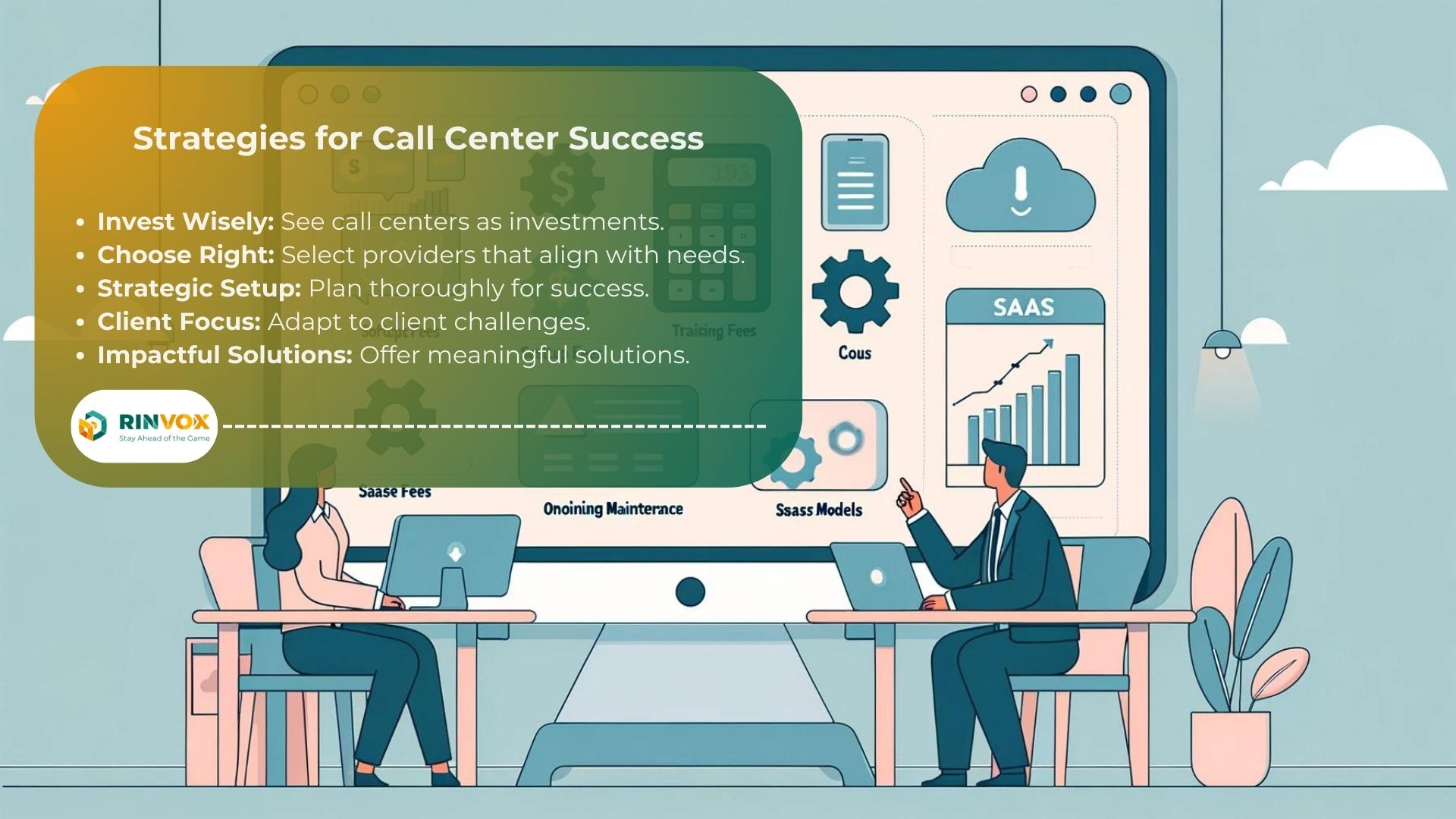
Strategic Planning for Call Center Excellence.
Technology Needs
Sometimes, you just need the basics.
- Standard Software Licenses: A typical software license for your call center costs $50 to $150 per person monthly. This includes call sorting, automated replies, and basic reports.
- Custom Integrations: Need to link your call system with other software or databases? Prices start at $10,000 and can rise with complexity.
- Custom Development: And if you’re thinking about a totally custom solution, tailored just right for your business? That could start at $20,000 and go way up to $100,000 or more.
Tip: Verify needs, consider cloud solutions for scalability and savings.
Ongoing Maintenance and Support
Buying software isn’t just a one-time expense. You need to think about the costs of keeping it running well over time.
- Maintenance Costs: These usually come every year and can run between 10% and 20% of what you initially paid. This fee helps take care of any updates, fixes for glitches, and getting help when you need it.
- Support Options: Support costs range from $500 to $2,000 annually, depending on your needs. Service contracts can help manage these maintenance and support expenses.
Tip: Opt for inclusive, scalable support plans to save costs.
Understanding Call Center Costs
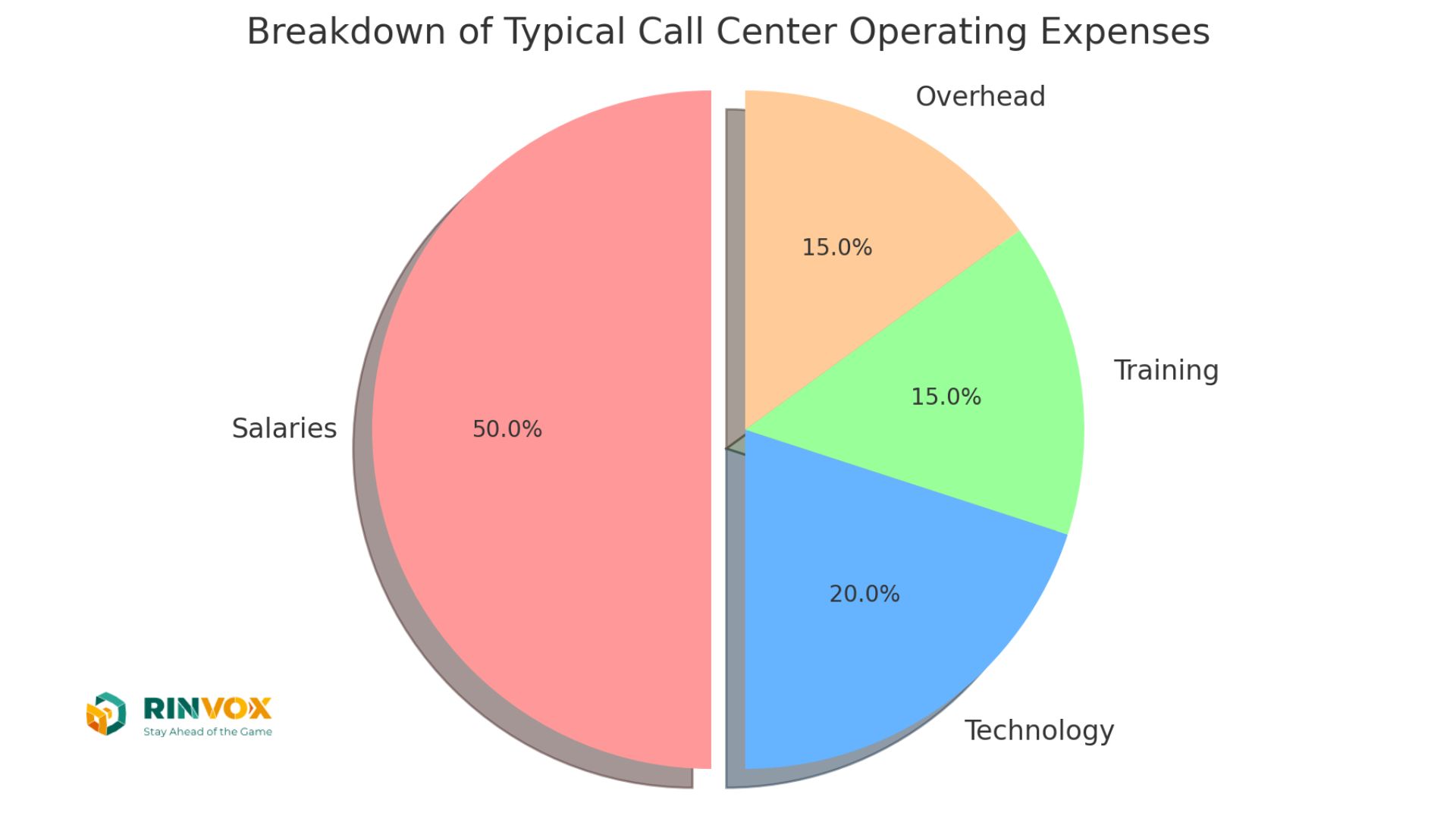
Distribution of Operating Expenses in Call Centers at Rinvox.
Here’s a quick rundown of typical expenses involved in running a call center:
Budget Basics: Pay, Perks, and Prep
- Pay: Most of your budget will probably go to salaries. For instance, in the U.S., a typical call center worker might earn between $30,000 and $40,000 a year. In places like the Philippines or India, that range drops to about $5,000 to $10,000.
- Perks: On top of salary, benefits like health insurance or pension plans can increase costs by another 20% to 30%, depending on where you are and what you offer.
- Prep: Training new folks isn’t cheap either. You’re looking at $1,000 to $2,500 each, based on how complex the job is and how long they need to learn the ropes.
Tip: Forecast demand, adjust staffing, invest in training.
Technology: Software, Hardware, and Internet
- Software: Each agent might cost you about $50 to $150 a month for the software they use. This depends on what kind of tools or features you need.
- Hardware: For the basics, like a computer and headset for each agent, you’re looking at spending anywhere from $500 to $1,500.
- Internet: You’ll need good, reliable internet to keep everything running smoothly. This could cost you anywhere from $100 to $500 a month, depending on how fast you need it to be and where you’re located.
Tip: Opt for cloud solutions to cut hardware costs.
Operational Costs: Outbound Call Charges and Internet Usage
- Outbound Call Charges: Outbound calls can add up quickly. Outsourcing to call centers might save money with bulk rates. Local calls cost 1-5 cents, international 15-50 cents per minute.
- Internet Usage: Besides your monthly bill, extra charges may apply if you exceed your data limit or need special services to maintain smooth operation. Manage costs effectively to save.
Tip: Negotiate bulk rates, monitor data to cut costs.
Tips for Cost-Effective Call Center Operations
To optimize your call center budget:
Effective resource allocation can help optimize costs and improve efficiency.
Forecast Usage: Accurate Predictions to Avoid Unexpected Costs
- Accurate Forecasting: Use past trends to estimate call volume, ensuring you have the right staff levels to avoid unnecessary costs and improve efficiency.
- Implementation: Consider investing in software that predicts busy periods. It costs $30 to $100 per user monthly, but it’s worth it for smoother operations.
Tip: Utilize analytics for smarter staffing and cost control.
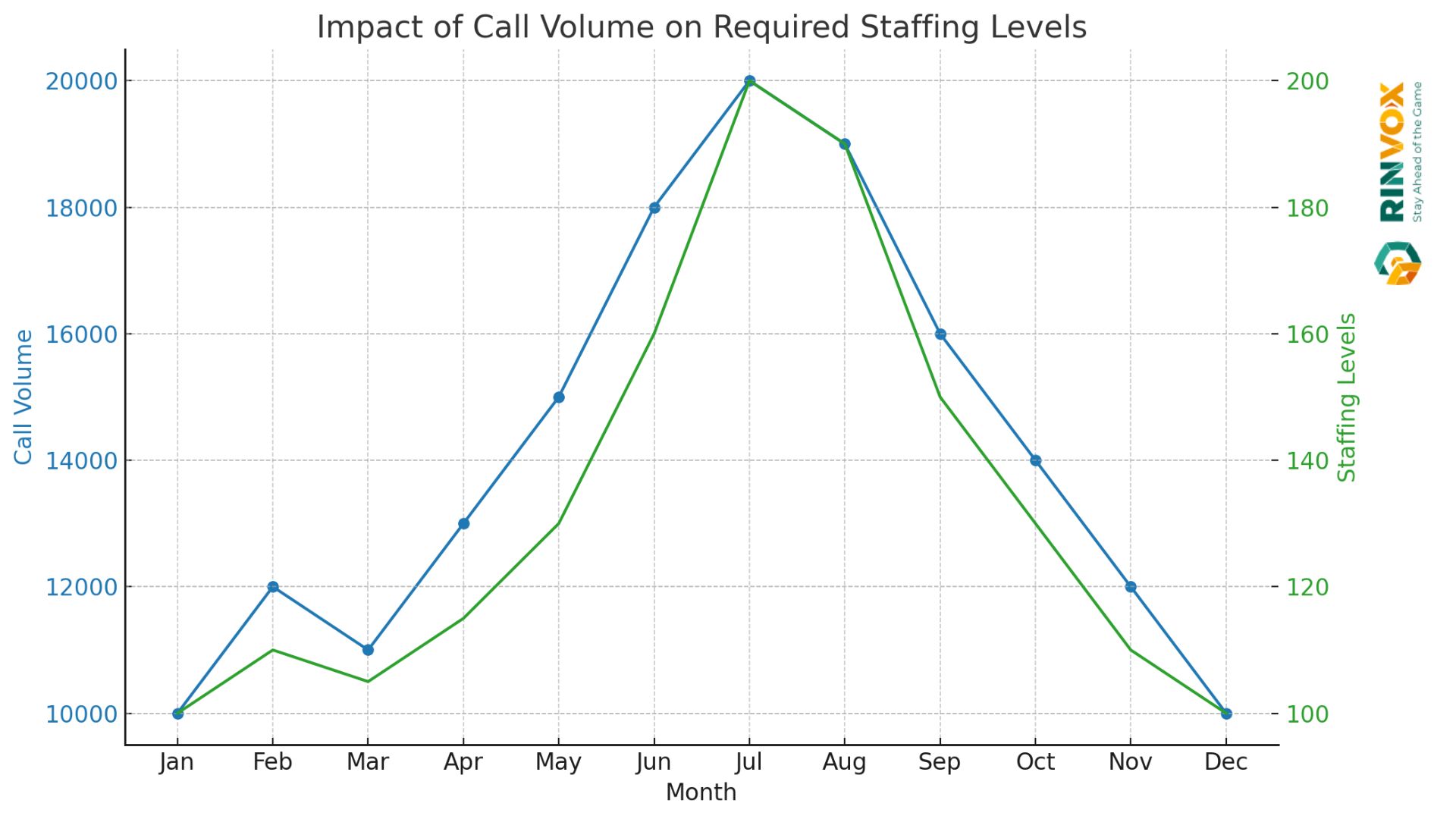
Monthly Call Volume vs. Staffing Levels at Rinvox.
Buy Smart: Invest in What You Need
- Needs Assessment: Review your tech and tools. Decide what’s necessary and what’s extra. This helps cut costs on non-essential items.
- Cost-effective Purchasing: When buying new tech, opt for scalable products like a basic cloud-based call center system, starting at $50 per agent monthly, allowing future enhancements as needed.
Tip: Implement tech gradually; upgrade as business needs grow.
Reduce Waste: Streamline Tools and Services
- Check Your Resources: Review your current tools to spot any inefficiencies or redundancies. Consider automating tasks like call logging to save time and reduce errors.
- Smart Tools for Managing Resources: Use smart tools to efficiently schedule staff and route calls, optimizing resources and cutting waste. Costs range from $20 to $60 per user monthly.
Tip: Regularly audit tools to eliminate redundancies and cut costs.
Bottom Line
A call center isn’t a cost; it’s an investment to be a game-changer for your business if you set it upright.
Think about everything from who you hire and how you train them to the tech you use and how you roll it out.
Picking the right call center provider means looking beyond the price tag to find a partner who gets what your business needs and can deliver on it.
At Rinvox, we’re all about tuning into our client’s unique challenges and offering solutions that truly make an impact.
Strategic planning is crucial for setting up a successful call center that meets business needs.

Strategic Planning for Call Center Excellence.
FAQs on Contact Center Pricing
Average Cost Per Contact in a Call Center
The cost per call in a call center varies, typically ranging from $1 to $10, while emails or chats may cost between 50 cents and $5.
How to Calculate Call Center Cost
Figuring out how much it costs to run a call center is pretty straightforward: tally all expenses, then divide by the number of handled calls or contacts to determine the cost per interaction.
How to Calculate Contact Price
To calculate contact price, sum your call center’s operating costs and divide by the number of calls. This helps set prices and manage your budget effectively.
What is Cost Per Customer Contact?
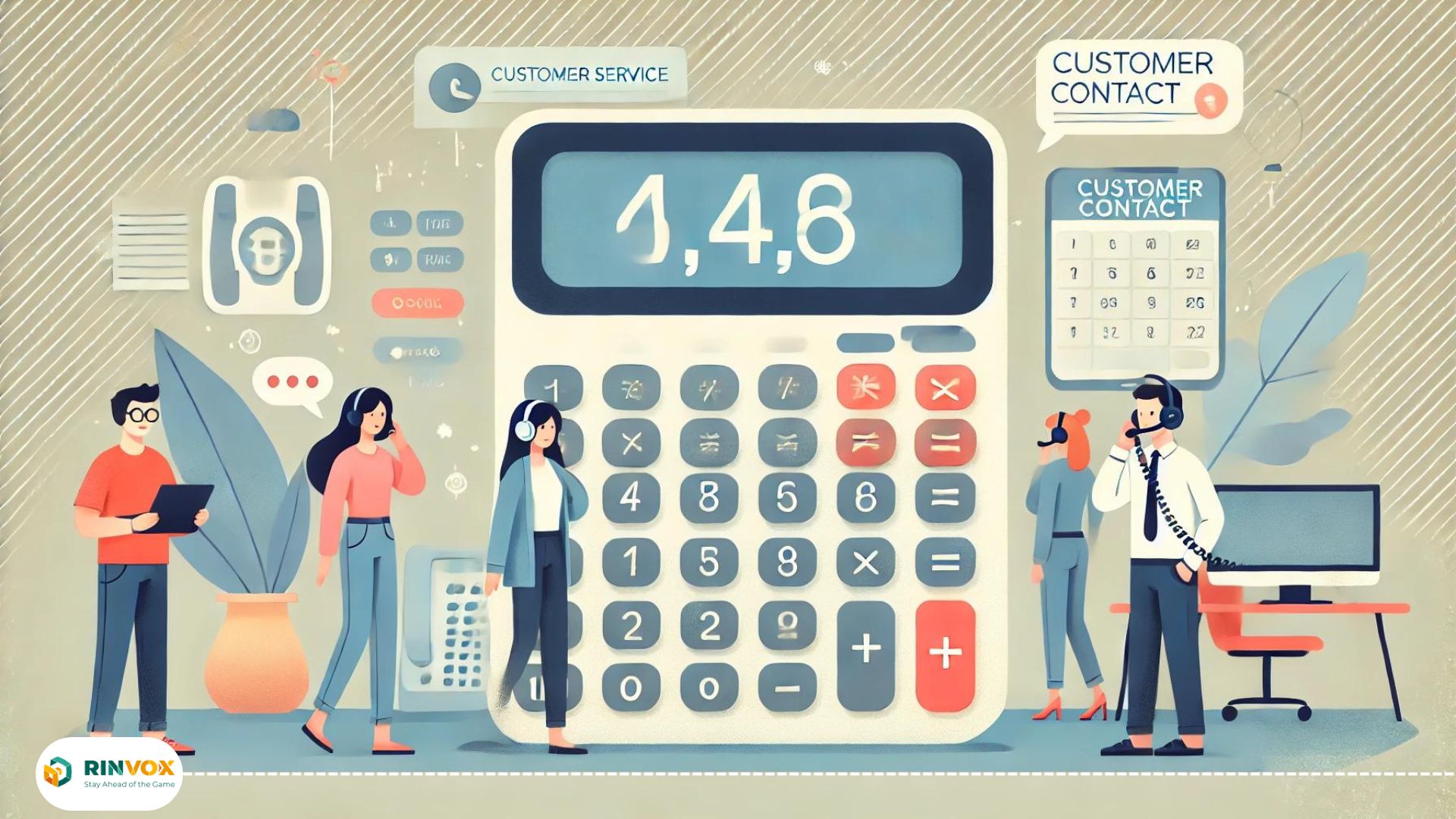
Visualizing Cost Per Customer Contact at Rinvox.
Cost Per Customer Contact calculates the total expense of each customer interaction in a call center, including staff, technology, and overhead costs, aiding in budgeting and performance assessment.
What is a Call Center Fee?
A call center fee covers the costs for handling customer service, charged per call, per minute, or monthly, supporting staff, technology, and operational expenses.
How to Calculate Contact Per Order
Just take the total number of times you talked to customers and divide it by how many orders you got. This helps you see if your team is doing a good job at making sales without needing too many calls.
How Do You Calculate Call Price?
To calculate call cost, sum up expenses for staff, phone bills, and overhead. Then, divide by the number of calls to get the cost per call.
What is Cost Per Call (CPC)?
Cost Per Call (CPC) measures the average expense of handling a call in a call center. Calculate it by dividing total costs (staff, technology, overhead) by the number of calls handled.
What is the Formula for Cost Center?
Here’s a formula to calculate call center costs: total Costs = (Number of Agents x Salary per Agent) + Technology Costs + Administrative Expenses + Training Costs.
What is Contact Center Pricing?
Contact pricing varies by call complexity, agent expertise, and operational efficiency. Rates typically range from $1 to $5 per interaction. For precise pricing, review your operational costs and customer service demands.
More articles


